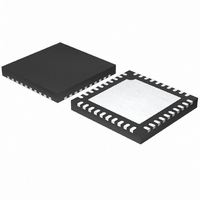MAX9598CTL+ Maxim Integrated Products, MAX9598CTL+ Datasheet - Page 13

MAX9598CTL+
Manufacturer Part Number
MAX9598CTL+
Description
IC SWITCH DUAL SCART 40TQFN
Manufacturer
Maxim Integrated Products
Datasheet
1.MAX9598CTL.pdf
(36 pages)
Specifications of MAX9598CTL+
Function
Switch
Circuit
2 x SCART
On-state Resistance
7 Ohm
Voltage Supply Source
Single, Dual Supply
Voltage - Supply, Single/dual (±)
3 V ~ 3.6 V, ±11.4 V ~ 12.6 V
Operating Temperature
0°C ~ 70°C
Mounting Type
Surface Mount
Package / Case
40-WFQFN Exposed Pad
Maximum Operating Temperature
+ 70 C
Minimum Operating Temperature
0 C
Mounting Style
SMD/SMT
Supply Voltage Range
3V To 3.6V, 11.4V To 12.6V
Operating Temperature Range
0°C To +70°C
Digital Ic Case Style
TQFN
No. Of Pins
40
Peak Reflow Compatible (260 C)
Yes
Filter Terminals
SMD
Rohs Compliant
Yes
Leaded Process Compatible
Yes
Lead Free Status / RoHS Status
Lead free / RoHS Compliant
The TV audio channel incorporates a zero-crossing
detect (ZCD) circuit that minimizes click noise due to
abrupt signal level changes that occur when switching
between audio signals at an arbitrary moment.
To implement the zero-crossing function when switch-
ing audio signals, set the ZCD bit high (Audio Control
Register 00h, bit 6). Then set the mute bit high (Audio
Control Register, 00h, bit 0). Next, wait for a sufficient
period of time for the audio signal to cross zero. This
period is a function of the audio signal path’s low-fre-
quency 3dB corner (f
time period to wait for a zero-crossing detect is 1/20Hz
or 50ms.
After the wait period, select a new audio source for the
TV audio channel by writing to bits 1 and 0 of the TV
Audio Control Register (01h). Finally, clear mute (Audio
Control Register, 00h, bit 0) but leave ZCD (Audio
Control Register, 00h, bit 6) high. The MAX9598 switch-
es the signal out of mute at the next zero crossing. See
Tables 10 and 11.
The MAX9598 audio output amplifiers feature Maxim’s
DirectDrive architecture, thereby eliminating the need
for output-coupling capacitors required by conventional
single-supply audio line drivers. An internal charge
pump inverts the positive supply (VAUD), creating a
negative supply (CPVSS). The audio output amplifiers
operate from these bipolar supplies with their outputs
biased about audio ground (Figure 2). The benefit of
this audio ground bias is that the amplifier outputs do
not have a DC component. The DC-blocking capacitors
required with conventional audio line drivers are unnec-
essary, conserving board space, reducing system cost,
and improving frequency response.
Conventional single-supply audio line drivers have their
outputs biased about a nominal DC voltage (typically
half the supply) for maximum dynamic range. Large
coupling capacitors are needed to block this DC bias.
Clicks and pops are created when the coupling capaci-
tors are charged during power-up and discharged dur-
ing power-down.
The MAX9598 features a low-noise charge pump that
requires only two small ceramic capacitors. The
580kHz switching frequency is well beyond the audio
range and does not interfere with audio signals. The
switch drivers feature a controlled switching speed that
minimizes noise on the video outputs generated by
turn-on and turn-off transients.
______________________________________________________________________________________
L3dB
). Thus, if f
Low-Power Audio/Video Switch for
Clickless Switching
L3dB
Audio Outputs
= 20Hz, the
Dual SCART Connectors
The SCART standard specifies 2V
for audio signals. As the audio circuits process
0.5V
MAX9598, the gain-of-4 output amplifiers restore the
audio signals to a full scale of 2V
To select which audio input source is routed to the TV
SCART connector, write to bits 1 and 0 of the TV Audio
Control Register (01h). To select which audio input
source is routed to the VCR SCART connector, write to
bits 3 and 2 of the TV Audio Control Register (01h). The
power-on default is for the TV and VCR audio outputs to
be muted (the inputs of the output amplifiers are con-
nected to audio ground). See Tables 8 and 11.
The video circuit routes different video formats between
the set-top box decoder, the TV SCART connector, and
the VCR SCART connector. It also routes slow-switch
and fast-switch control information. See Figure 3.
Figure 2. Conventional Driver Output Waveform vs. MAX9598
Output Waveform
RMS
full-scale audio signals internal to the
CONVENTIONAL DRIVER-BIASING SCHEME
DirectDrive BIASING SCHEME
V
OUT
V
OUT
RMS
RMS
.
Video Section
V
GND
GND
as the full-scale
V
+V
-V
DD
DD
DD
DD
/2
13











